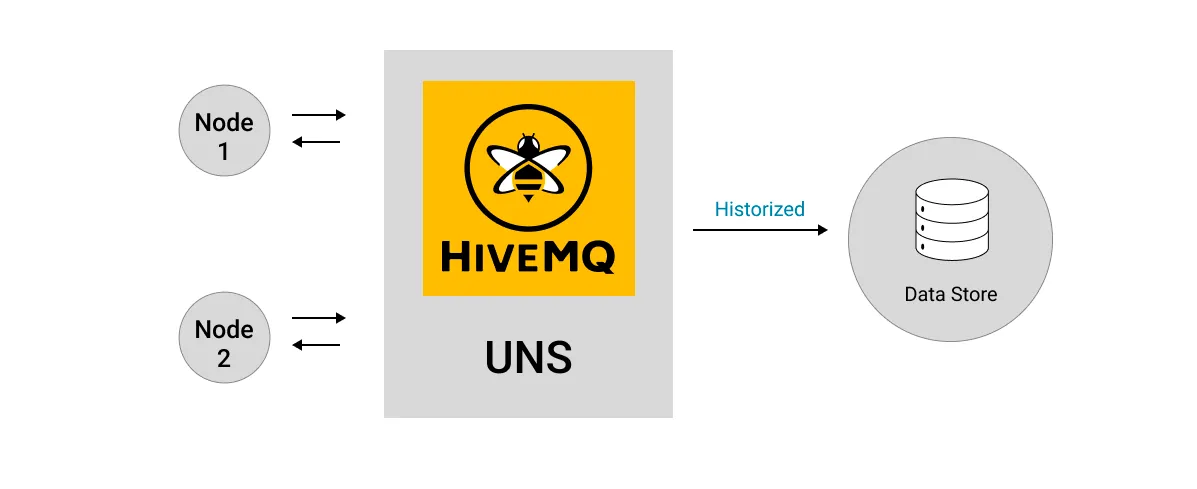Integrating a Historian into Unified Namespace
The Unified Namespace (UNS) is a dynamic and scalable industrial IoT architecture that provides seamless real-time data sharing and communication among various systems and components within a manufacturing environment. This framework supports real-time decision-making and improves the adaptability of operations.
Yet, to fully realize the potential of the UNS architecture, it's critical to incorporate data historicization in the system. This article explores the details of integrating a Historian into the UNS, highlighting the benefits, strategies, and considerations for achieving a seamless and efficient historical data integration.
The Role of Historian in Manufacturing Digital Transformation
Historians offer a comprehensive solution for capturing, storing, and analyzing data generated in manufacturing environments. Here's a detailed look at a historian’s role in the context of digital transformation in manufacturing:
Data Capturing and Aggregation: Historians are vital for real-time data collection from various sources in the manufacturing process, such as sensors and machines. They aggregate this data, offering a unified view essential for real-time monitoring, analysis, and decision-making.
Data Storage and Management: These systems are engineered to efficiently manage vast amounts of time-series data, using compression techniques for compact storage without losing data integrity. They support long-term data retention, facilitating access to historical data for trend analysis and process improvement.
Data Analysis and Insights: Historians enable trend analysis by examining historical and real-time data to identify patterns, anomalies, and trends. This capability is key for predictive maintenance, quality control, and enhancing operational efficiency through performance benchmarking.
Supporting Predictive Maintenance: By supplying detailed historical data, historians underpin advanced analytics and machine learning models that predict equipment failures before they occur, helping to minimize downtime and maintenance costs.
Enhancing Operational Efficiency: Insights from historical data can lead to process optimization, improved throughput, reduced waste, and better energy management by tracking and analyzing energy usage patterns.
Regulatory Compliance and Reporting: Historians ensure compliance in regulated industries by providing accurate, traceable data for compliance reporting and creating detailed audit trails, which are crucial for quality assurance and meeting regulatory standards.
Why Historians Need to be Integrated into UNS
Promoting Open Architecture
To overcome the proprietary nature of the connectivity interface of many Historians, which makes utilization of their data by other applications difficult, organizations need to integrate Historians into a data infrastructure that uses open and standardized data exchange mechanisms, such as MQTT for the Unified namespace.
This approach reduces dependency on specific vendors and lowers the barriers to data access, aligning with the UNS's open and scalable connectivity principles.
Bridging Event-Handling Gaps
To address the limited event-handling capabilities of Historians, an integration platform can be used to bridge this gap. This software layer, typically an IIoT platform, can listen to data changes in the Historian and then publish these changes to the UNS. It can also listen to data changes in the UNS and subsequently perform transactions in the Historian. By doing so, it enables change-based notifications and the publish-subscribe model, allowing real-time data interaction and dynamic event handling across different applications.
Enriching Data Models
Due to the lack of complex data models, Historians alone cannot provide enough information required to add an intelligence layer to industrial operations. The lack of complex data models in Historians can be mitigated by implementing data transformation and contextualization layers within the UNS architecture. These layers can enrich the raw time-series data with context, relationships, and metadata, transforming it into a structured format that supports advanced analytics and decision-making processes.
Storing the Unified Namespace Data into the Historian
A Historian, essentially a time-series database, is dedicated to capturing, storing, and managing historical data. It plays a vital role in the UNS architecture by subscribing to the UNS and archiving data over time.
 This enables retrospective analysis and insight generation, which are crucial for informed decision-making and operational improvement. The historian mirrors the live data model of the UNS but with the key difference of maintaining a historical record. This means that in addition to having a real-time snapshot of your operation’s current state and events in the MQTT broker, there's also a single source of truth for historical data in the Historian.
This enables retrospective analysis and insight generation, which are crucial for informed decision-making and operational improvement. The historian mirrors the live data model of the UNS but with the key difference of maintaining a historical record. This means that in addition to having a real-time snapshot of your operation’s current state and events in the MQTT broker, there's also a single source of truth for historical data in the Historian.
Furthermore, REST endpoints can be set up to query this historical data. These data queries can then be published back into the UNS at the appropriate level of the semantic hierarchy, making historical insights actionable within the Unified Namespace.
Some historians would use their Asset Model to expose the structure of the UNS, enabling clients to browse and discover the UNS data structure using protocols like OPC UA. This feature provides a way for users to understand and interact with the organization of their UNS through a standardized browsing method.
Publishing Historian Data into The Unified Namespace
Data historicization within the UNS framework is not just about storing past data but also curating insights from the historical data to make it accessible in the Unified Namespace. When effectively leveraged, historical data can provide a backdrop against which current operations are measured and evaluated. This comparison can reveal deviations from expected performance, identify areas for improvement, and highlight operational efficiencies or inefficiencies. Such a strategic integration of historians into the UNS architecture significantly enhances operational intelligence.
 The integration process involves connecting the historian with the IIoT platform that manages the UNS, ensuring that historical data is easily accessible through the same platform. This integration allows for establishing REST endpoints to query historical data, making these queries relevant within the UNS by publishing them back to an appropriate level of the semantic hierarchy.
The integration process involves connecting the historian with the IIoT platform that manages the UNS, ensuring that historical data is easily accessible through the same platform. This integration allows for establishing REST endpoints to query historical data, making these queries relevant within the UNS by publishing them back to an appropriate level of the semantic hierarchy.
Challenges and Considerations in Historian Integration
The integration of historians into the UNS architecture, while offering numerous benefits, also presents several challenges and considerations:
Data Structure and Fluidity: The UNS's dynamic nature means its structure can evolve to meet changing business needs. Historians must, therefore, be capable of adapting to these changes, ensuring historical data remains relevant and accurately mapped to the current UNS structure.
Technology Stack Compatibility: The choice of technologies for both the historian and the UNS must ensure seamless integration, efficient data flow, and compatibility. This includes considerations for data capture mechanisms, storage formats, query capabilities, and data publication methods. Suppose a Historian cannot natively talk MQTT. In that case, you will need an intermediary system like an IIoT platform to interface with the UNS through MQTT for real-time data sharing and REST APIs for historical data queries. The choice of technology should also consider the ease of updating metadata and the ability to handle both schema-less and structured data efficiently.
Scalability and Performance: As the volume of data generated by IIoT devices grows, the Historian and UNS must scale accordingly. This requires careful planning to ensure that the Historian can handle increased data loads without sacrificing performance or accessibility.
Security and Data Integrity: Integrating a Historian into the UNS architecture introduces additional data security and integrity considerations. Ensuring that historical data is securely stored, accurately captured, and protected from unauthorized access is paramount.
Conclusion
Integrating a historian into the Unified Namespace architecture is a strategic move toward achieving comprehensive and efficient data management in industrial operations. By capturing and utilizing historical data within the UNS framework, organizations can unlock valuable insights, drive operational excellence, and prepare for future challenges with a solid foundation of historical context. As the technology landscape evolves, so too will the strategies for integrating and leveraging historians within the UNS, ensuring that businesses remain agile, informed, and ahead of the curve.
Next up in this series, we discuss how to integrate an MES into the Unified Namespace. Read on. Are you new to Unified Namespace and trying to understand it? Watch our webinar on Achieving Data-Driven Manufacturing with UNS and MQTT Sparkplug.

Kudzai Manditereza
Kudzai is a tech influencer and electronic engineer based in Germany. As a Sr. Industry Solutions Advocate at HiveMQ, he helps developers and architects adopt MQTT and HiveMQ for their IIoT projects. Kudzai runs a popular YouTube channel focused on IIoT and Smart Manufacturing technologies and he has been recognized as one of the Top 100 global influencers talking about Industry 4.0 online.
